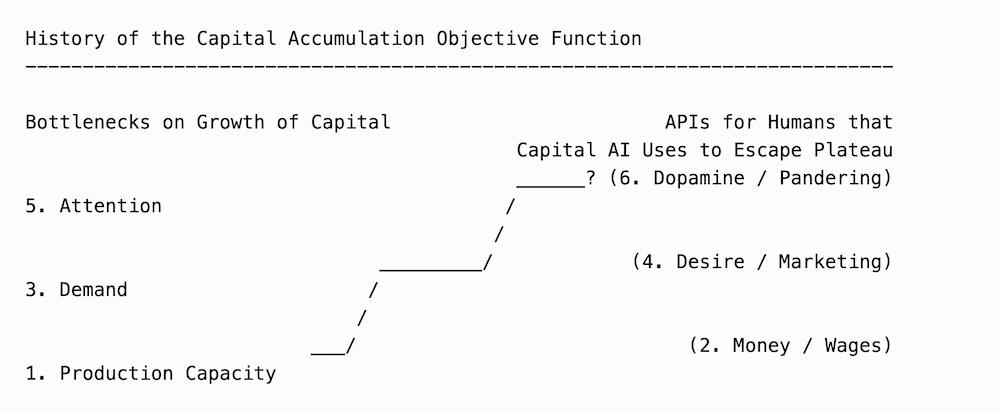
This is a lengthy discussion, so I’ll begin with a summary.
The basic idea in this post is to consider capitalism as a highly efficient objective function (or “AI”) with its parameters optimized for the satisfaction of our short term desires rather than our long term interests.
Paranoia about runaway feedback loops – in consumer capitalism, artificial intelligence, mass media, ‘Wrestlemania politics,’ etc – ultimately stems from the inscrutability of the emergent behavior of these complex systems to the individual actors and observers operating within them.
Rather than responding with Luddite / anarchist nihilism, we should remember that technological and social systems like these have dramatically reduced our exposure to the unpredictability of the natural world and greatly improved living conditions on a number of dimensions over the past few centuries.
At the same time, we should not ignore warning signs of a dystopian future, nor should we hope that a ‘personnel change’ of institutional leaders will solve our problems.
Because the problems at hand are complex systems problems – where the root causes are not the actors themselves, but the ill-designed structures and incentives that dictate their actions – we should think about redesigning the rules and incentives of social, political, and economic systems as the path forward.
After making the case for how we can better understand these systemic failures, I’ll discuss some frameworks that might be useful places to look for solutions, and then I’ll conclude by proposing a few examples of structural changes that might lead towards better outcomes. (Feel free to skip to the Practical Recommendations section, if that is where your interest lies.)

When I first moved to California, a few years ago, I lived in a bunch of different apartments on short term, month-to-month leases. I was moving around a lot, traveling light, and in one of these moves I lost my tooth brush.
I made no urgent effort to replace it – instead, I just brushed my teeth with my finger.
Whenever I stopped by a bodega late at night, I checked if they sold toothbrushes. One place was sold out. Others just didn’t sell them. Another time I saw a place that looked like they would have them in stock for sure, but I saw some patrons at the counter wearing gingham plaid, got anxious, and decided not to go in.
It got to be a week or two with no toothbrush and one Saturday afternoon I mustered the willpower to go to a Safeway and “just do it.”
As soon as I walked in, I got a bad feeling. The place was huge and even finding the toothbrush aisle seemed daunting. I’m sure I immediately started looking a little frantic.
I asked someone at the checkout where the toothbrush aisle was, and they pointed me in the right direction. I remember–and I am not making this up–that Bruce Springsteen’s “Everybody Has a Hungry Heart” was playing on the radio.
I found the toothbrushes and there must have been over a hundred options. I tried to remember the latest dental wisdom. I think you are supposed to get extra soft. I just wanted a cheap one, not one of the ergonomical-fancy-angled or rubber-grippy-comfort-handled ones. Shelves six feet tall and ten feet wide, and they were all fancy ones.
I conceded my “cheap” requirement. I saw an Ultra-Soft bristle one, reached for it, but it was only available in a 2 packs, and I only wanted 1 toothbrush.
Why are there so many choices but not the one I want? How am I spending over 5 minutes picking out toothbrushes?
The utter meaninglessness of this moment consumed my entire consciousness, and I just stood there, eyes widening with terror, or despair.
I eventually somehow found the courage to grab a just regular soft fancy handled one and found the self checkout.
Often when I tell people about this crack up, they laugh like it was a sitcom episode, so I want to try to unpack the gravity of the despair I felt during this experience for you.
I would seriously be OK if there was only a single toothbrush option on the planet. Yet there are hundreds of options at this supermarket.
Each of these toothbrushes was designed by a person. That person thought, you know, we have soft and medium and hard, but now we need extra soft. Or, we need one with a slight fatter handle. Or, a different angle handle.
Actually, distinct people probably “invented” each of these new toothbrushes. Then, each toothbrush inventor probably had to pitch their new and unique toothbrush to a committee to get feedback on whether or not they should add a new SKU to the product line. Perhaps they did a bunch of market research, prototyping, and user testing for each new design.
Someone had to model the potential demand for each toothbrush vs all the other toothbrushes. Ask questions like “will Extra Soft cannibalize our own Soft market share or win share from our competitors?”
People had to manufacture these toothbrushes, drive trucks carrying them to stores.
Store managers had to decide they wanted to carry each new toothbrush and devote shelf space to it.
And every person who walked down this Safeway aisle had to look through all of the options, spend time discerning the differences, and pick the best toothbrush for them.
How much human attention from how many people–each with an incredibly short time on this earth–went into everything necessary for this transaction to take place at this supermarket at this moment?
It’s disorienting if you take the time to think about it, and it just leaves you with this feeling that….
WE ARE NO LONGER IN CHARGE.

Some time later, I came across James Bridle’s There is something wrong on the internet, a report on the strange landscape of content production optimized for gaining views via the auto-play-next-video algorithm on YouTube:
[T]here is something weird about a group of people endlessly acting out the implications of a combination of algorithmically generated keywords: “Halloween Finger Family & more Halloween Songs for Children | Kids Halloween Songs Collection”, “Australian Animals Finger Family Song | Finger Family Nursery Rhymes”, “Farm Animals Finger Family and more Animals Songs | Finger Family Collection - Learn Animals Sounds”, “Safari Animals Finger Family Song | Elephant, Lion, Giraffe, Zebra & Hippo! Wild Animals for kids”, “Superheroes Finger Family and more Finger Family Songs! Superhero Finger Family Collection”, “Batman Finger Family Song — Superheroes and Villains! Batman, Joker, Riddler, Catwoman” and on and on and on. This is content production in the age of algorithmic discovery — even if you’re a human, you have to end up impersonating the machine.
YES, THE ROBOTS HAVE TAKEN OVER.

You’ve probably heard of notable people like Bill Gates giving warnings about the existential risks posed by artificial intelligence. One of the classic illustrations of a rogue AI is in Nick Bostrom’s paper Ethical Issues in Advanced Artificial Intelligence, where he imagines a superintelligent machine with the benign objective of manufacturing paperclips. An AI powered machine designed only to produce the maximum number of paperclips as efficiently as possible might ultimately start “transforming first all of earth and then increasing portions of space into paperclip manufacturing facilities” and enslave all of humanity it in pursuit of this goal.

It is not difficult to feel we have already reached the dystopian future in which we have been enslaved by “robots” like the toothbrush maximizer and the auto-play-next maximizer.
Really, though, it is probably more accurate to say that humanity has been enslaved by the capital maximizer.
Marx made this argument two hundred years ago:
[E]ven in the condition of society most favourable to the worker, the inevitable result for the worker is overwork and premature death, decline to a mere machine, a bond servant of capital….
…. The raising of wages presupposes and entails the accumulation of capital, and thus sets the product of labour against the worker as something ever more alien to him. Similarly, the division of labour renders him ever more one-sided and dependent, bringing with it the competition not only of men but of machines. Since the worker has sunk to the level of a machine, he can be confronted by the machine as a competitor. Finally, as the amassing of capital increases the amount of industry and therefore the number of workers, it causes the same amount of industry to manufacture a greater amount of product, which leads to over-production and thus either ends by throwing a large section of workers out of work or by reducing their wages to the most miserable minimum.
Marx didn’t use the phrase AI, but he is basically arguing that capitalism is a sort of superintelligent AI that uses money as the API* to instruct labor what to spend their time working on.
Marx also had the foresight to understand the ‘loopy’ nature of capitalism: capital commands not only what people work on or produce, but its influence inevitably grows to dictate also what they consume:
Under private property… every person speculates on creating a new need in another, so as to drive him to a fresh sacrifice, to place him in a new dependence and to seduce him into a new mode of gratification and therefore economic ruin. Each tries to establish over the other an alien power, so as thereby to find satisfaction of his own selfish need.
Excess and intemperance come to be [the] true norm [of the modern economic system]. Subjectively, this is even partly manifested in that the extension of products and needs falls into contriving and ever-calculating subservience to inhuman, refined, unnatural and imaginary appetites…. [Each person] puts himself at the service of the other’s most depraved fancies, plays the pimp between him and his need, excites in him morbid appetites, lies in wait for each of his weaknesses — all so that he can then demand the cash for this service of love.
Capitalism as AI
History of the Capital Accumulation Objective Function
----------------------------------------------------------------------------
Bottlenecks on Growth of Capital APIs for Humans that
Capital AI Uses to Escape Plateau
______? (6. Dopamine / Pandering)
5. Attention /
/
_________/ (4. Desire / Marketing)
3. Demand /
/
___/ (2. Money / Wages)
1. Production Capacity
I like to think about the evolution of the capital AI machine as a series of levels that were unlocked by new “learning” APIs to humans.
When the gating function on growth of capital was production capacity (1), the capital machine unlocked the next level by learning to command human working time through money in the form of wages (2).
Once production capacity was unlocked, the gating function became consumer demand (3), and the machine learned marketing (4) as a method for what Marx called “creating need.” (Take a second to think about this phrase literally and the almost supernatural power that manifesting it entails….)
Finally, once many of the parts of the machine have acquired the ability to create demand, there becomes competition for the attention necessary to incept desire in consumers (5). Here is where you start to see the attention hacking tactics (6) pervasive in our modern media landscape: guarantees of the immediate satisfaction of short term desire, empty promises, pandering to sameness and tribe, ad hominem attacks against the “other,” etc.

In E Unibus Pluram: Television and U.S. Fiction, David Foster Wallace gives an astute analysis of the dynamics between humans (Audience with a capital A) and the attention commanding function of the capital machine (in the form of the television mass media industry, but everything he describes is true of all mass media, perhaps more true of internet mass media than it was of TV). He says:
There is a lot of money at stake, after all; and television retains the best demographers applied social science has to offer, and these researchers can determine precisely what Americans in 1990 are, want, see: what we as Audience want to see ourselves as. Television, from the surface on down, is about desire. Fictionally speaking, desire is the sugar in human food.
To me, mass media feels not so much like sugar as it does chocolate chip cookies, fresh out of the oven. There’s the delicious smell, warm and gooey texture, and sugary sweetness, yes, but also salt that makes you want to eat more.
Wallace goes on to explain why the AIs that have emerged (into what we call mass media and consumerism) are optimized for satisfaction of short term desires–calories, energy, clicks, hours watched–not our longer term values–dignity, knowledge, health, etc:
It’s undeniable that television is an example of “low” art, the sort of art that tries too hard to please. Because of the economics of nationally broadcast, advertiser-subsidized entertainment, television’s one goal - never denied by anybody in or around TV since RCA first authorized field tests in 1936 - is to ensure as much watching as possible…. I’m not saying that television is vulgar and dumb because the people who compose Audience are vulgar and dumb. Television is the way it is simply because people tend to be really similar in their vulgar and prurient and stupid interests and wildly different in their refined and moral and intelligent interests. It’s all about syncretic diversity: neither medium nor viewers are responsible for quality.
None of the actors within the system is malicious or stupid – their behaviors all make sense given their incentives as dictated by the rules of the system. This is true of television, of internet media, and of consumer capitalism broadly.

At this point, you’re probably thinking I’m an anti-capitalist / zealot / Luddite that is going to prescribe tearing down all of our capitalist institutions. That’s not where I’m headed.
There are lots of great properties of the capital AI, but before I get to them, I do want to acknowledge the truth behind the grievances of the anti-capitalists.
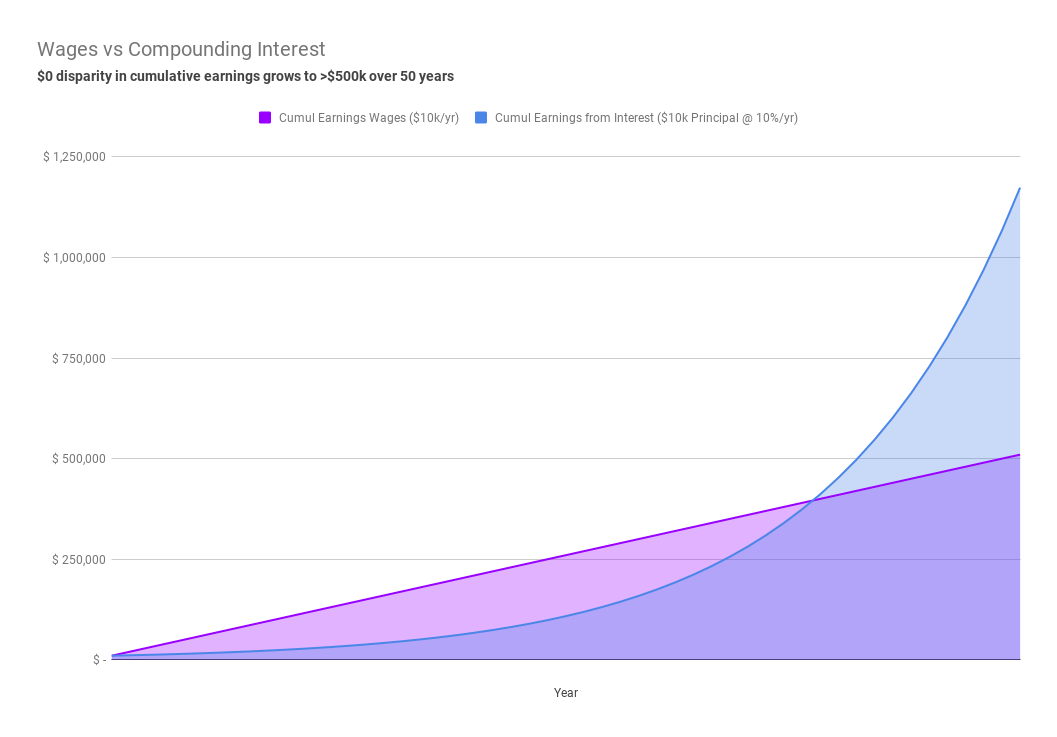
Capital grows exponentially as a result of compounding interest – so in any world where investment risk is compensated with interest, it is tautological that “the rich get richer.”
Capital investors will build far more wealth in a matter of a few generations compared to those who work for wages.
Capitalism by its nature tends toward disparity of wealth.

By many other measures, however, economic growth under global capitalism during the last two centuries has resulted in huge improvements in the standard of living for a huge percentage of the population (even as the global population has grown exponentially).
There have been massive declines in extreme poverty and child mortality, huge advances in basic education and literacy, for example.
Economic disparity is a fundamental result of interest returns, which we use to compensate investors for taking on the risk of funding innovation, large projects like research and infrastructure, education, etc. It is just this sort of capital investment that has led to many of the gains depicted in these charts.
So on one side, you have the socialist leaning left up in arms about increasing economic disparity, and on the other side, you have the free market capitalists saying, “look, things are actually getting better for everyone.”
And both of them are correct.
But you don’t hear many people acknowledging both of these truths at the same time. Instead, you tend to hear each side yelling their truth at the other side with the implicit claim that if one side is right, the other must be wrong.

Somewhat paradoxically, we can look to the poster child of the free market capitalists, Friedrich Hayek, for warnings about the dangers of both extreme economic disparity as well as those of the blind pursuit of absolute equality.
The problem with extreme economic disparity and the concentration of wealth in a small number of individuals or monopoly corporations is that this concentration of power is either ripe for exploitation either by a self-serving private individual or by a totalitarian state. Basically, the concentration of too much power in one place increases the risk / exposure at a single point of failure.
On the other hand, if a state were to pursue absolute equality as an end in and of itself, it would not suffice to achieve economic equality. There are many other forms of luck and nepotism that contribute to inequality – for example, some people are born with better access to education and mentorship, which leads to unequal accumulation of knowledge. Eliminating this inequality would entail that all parents forfeit children to the state at birth, so that no child benefits or suffers from the luck inherited from the habits and knowledge of the particular parents they were born to. In pursuit of absolute equality, we’d sacrifice a huge amount of intellectual diversity and personal freedom, again, increasing our exposure to catastrophic risk.
There’s totalitarianism on both sides.

But, the thing is, absolutes are a much easier sell than middle paths.
And, politicians are part of the same attention economy competing for your eyeballs as all of the companies trying to drive your consumption of media and products. They need to sell their ideas and policies with marketing tactics if they are going to have the opportunity to enact any policy.
We call their special brand of marketing “propaganda,” and probably the first thing that comes to mind when we think of propaganda is Soviet propaganda.

But American propaganda looks a lot like Soviet propaganda, when you put aside your personal biases and trade the color yellow for the color blue – well-groomed, middle-aged elites, parading around their families as proof of their moral character and trustworthiness…

… or, outsider / populist insurgents.
The recent success of outsiders building massive followings on both sides – Trump, for example, on the right, and Obama and AOC on the left – is evidence of a growing popular distrust of institutions. This is likely the result of (i) the inscrutability of the complex behavior of the capital AI machine we have built and (ii) the disconnect between the short term desires it is optimized to satisfy versus the long term benefits we’d want from the system that dictates the bounds of our economic and quality of life outcomes.
In The Revolt of The Public and the Crisis of Authority in the New Millennium, Martin Gurri summarizes the modern populist platform as nihilism – their propaganda consists almost entirely of calls for the destruction of broken institutions without any concrete designs for replacements.
At best, you might view their proposed solution as a personnel change – even Gurri, who so astutely analyzes the problem, concludes his book with only a plea for leaders with greater humility and honesty.
Attributing blame to the actors operating within our current attention economy democracy and recommending a personnel change as the solution misses the point, however. Recall David Foster Wallace’s argument that the root cause of the degradation of media was not the result of bad actors–either on the Audience side or on the production side–but the result of the system of incentives within which all of these actors were operating.
Expecting new and “better” personnel to behave differently within the same structure and system of incentives is a wishful thinking (if not outright delusional). The incentives of our institutional leaders are defined by how we measure them – and the objective function of a politician is optimized not results but for votes. The rhetoric of a politician–ad hominem attacks of opponents, xenophobia and distrust of the other, polarizing propaganda couched in terms of absolutes, in short, everything that would behoove the type of person Hayek describes in his argument for “why the worst get on top” in politics–will not change until we change the structure and system of incentives politicians are working within.

Because we have (rightfully) lost faith in our institutional leaders and the systems of incentives that govern their behavior, but we do not yet have a replacement system, we now find ourselves in a dangerous transitional period.
With the President constantly inspiring doubt in “fake news,” with the media industry chasing clicks and eyeballs rather than truth, with both the extreme left and extreme right casting stones at even the scientific method and enlightenment thinking, the public is left without trust in anything.
This is problematic because many of our institutions only work because we trust that they do–the government authority that gives us the freedom to enter into contracts with others, the rules which we follow given our trust that others will do the same rather than free riding, the basic ideas of civil rights, fiat currency–all of these are just socially constructed phenomena which have been created by people. They exist only because people believe in them and believe that others do (or, at the very least, they believe that their government deserves legitimate authority and will enforce these ideas).
If we lose too much faith in institutions too quickly, our institutions will lose the authority to enforce all of these norms and we could easily slip into a state of anarchy.
If we cannot trust actors within the current structure of incentives to get us out of this predicament, how can we approach solving these problems?
First, I think we need to reframe the discourse around the problems in terms of “Systems Thinking,” rather than in terms of good and bad actors.
Once we’re talking in terms of systems, we might look for ideas for solving our structural, systemic failures in fields like Game Theory and Distributed Systems Engineering.
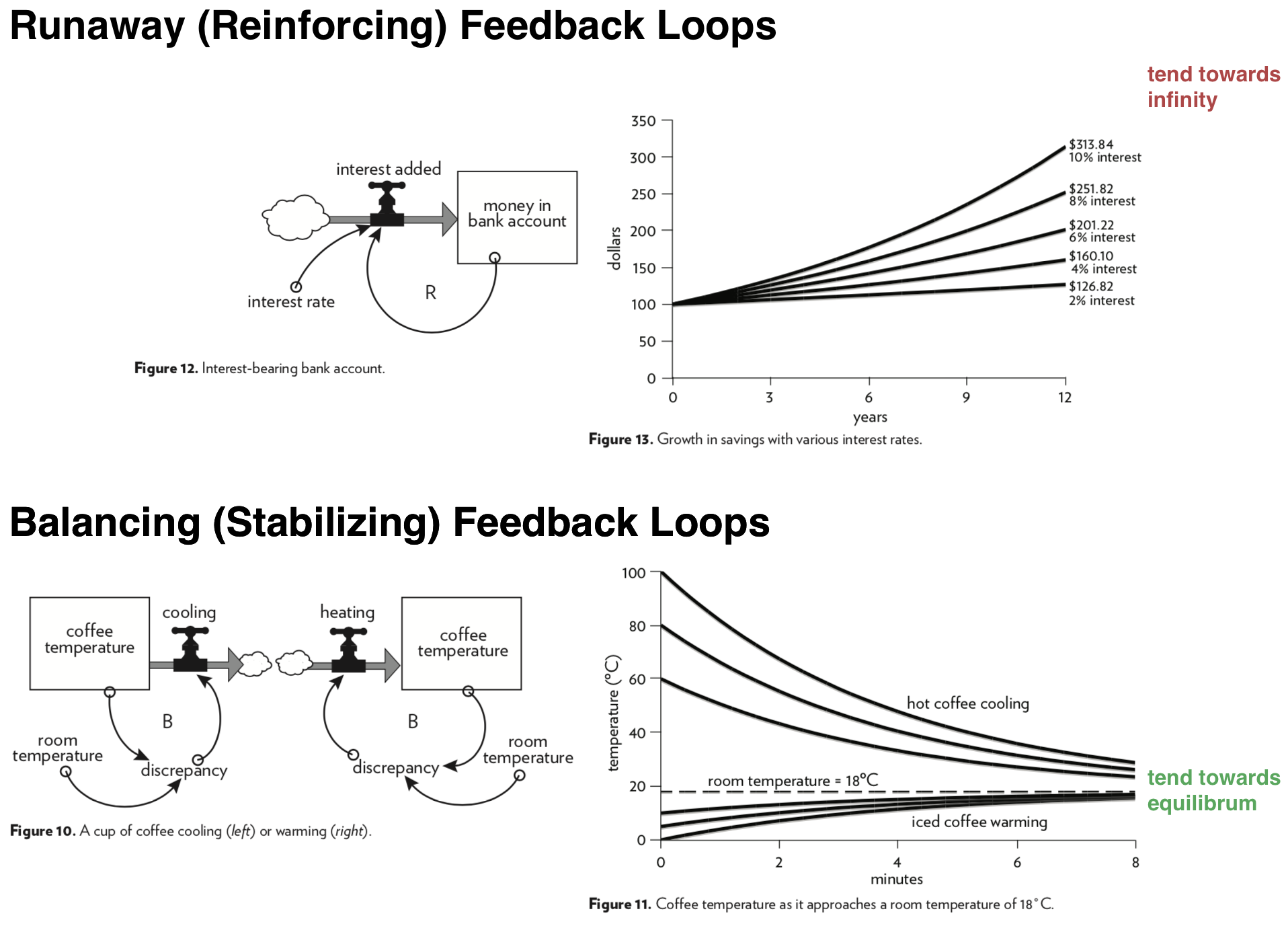
When I think about everything that is wrong with our society, I constantly find myself falling into the trap of “hating the player” and forgetting that the behavior of the player is dictated by the rules of the game.
Hating the player is not a productive framework for generating solutions, so I have to constantly remind myself to get into a Systems Thinking framework when I’m thinking about improving our broken institutions (for an excellent primer on this field I recommend Donella Meadows’ Thinking in Systems). So, rather than talking about how bad an individual politician, party, corporation, or special interest group is, the discussion becomes: what are the incentives that might lead an actor with this position in the system to behave this way? How might we change the incentives or rules of the system to lead to different outcomes?
The other crucial concepts to steal from systems thinking are about side effects and feedback loops.
Typically, our large scale social and institutional problems involve complex systems of many types of actors with conflicting interests, all of whose behavior affects the behavior of other actors within the system.
Visualizing both the feedback loops (the loopy diagrams on the left) and the effects of these loops over a series of many iterations on a particular measure can make it much easier to reason about the long term implications of a particular policy (for example, you might think about redistribution or progressive taxation as a way to dampen the reinforcing feedback loop of compounding interest that makes the rich richer).
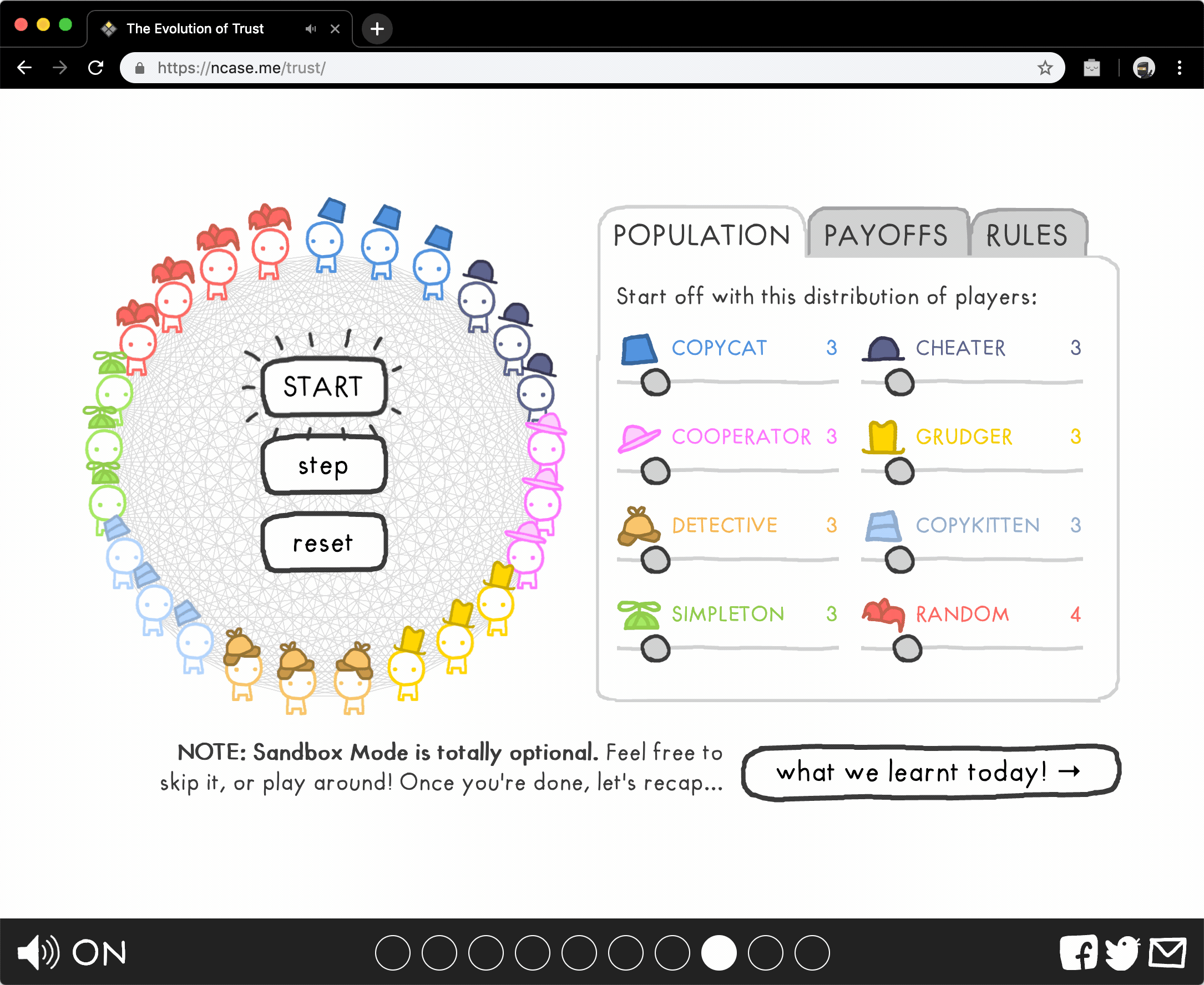
When we are concerned with social institutions, which are systems involving the interaction of a population of “optimizing agents,” it makes sense to consult the branch of mathematics that has been developed for modeling such systems: game theory.
To see how this branch of mathematics can be useful for thinking about complex social systems and policies, consider this animation from Nicky Case illustrating a classic example from game theory called the iterated prisoner’s dilemma. Here you can simulate different strategies for social norms (of cooperation and cheating) and explore how different initial distributions of norms evolve towards a terminal / emergent state of socially accepted / normative behavior.

Another field from which we might borrow design principles from for the sake of institutional reform is distributed systems engineering.
We can ignore the details of this architecture diagram from Netflix, and focus on a key design principle of systems engineering that it illustrates–fault tolerance. Distributed systems take the failure of any individual node as an eventuality that must be tolerated.
Building fault tolerant systems comes at a high cost: you always compromise speed and efficiency against the desirable features of distributed systems like fault tolerance, as well as durability, redundancy, consistency, availability, etc. (And often, you’re trading these desirable features not only against efficiency, but against each other.)
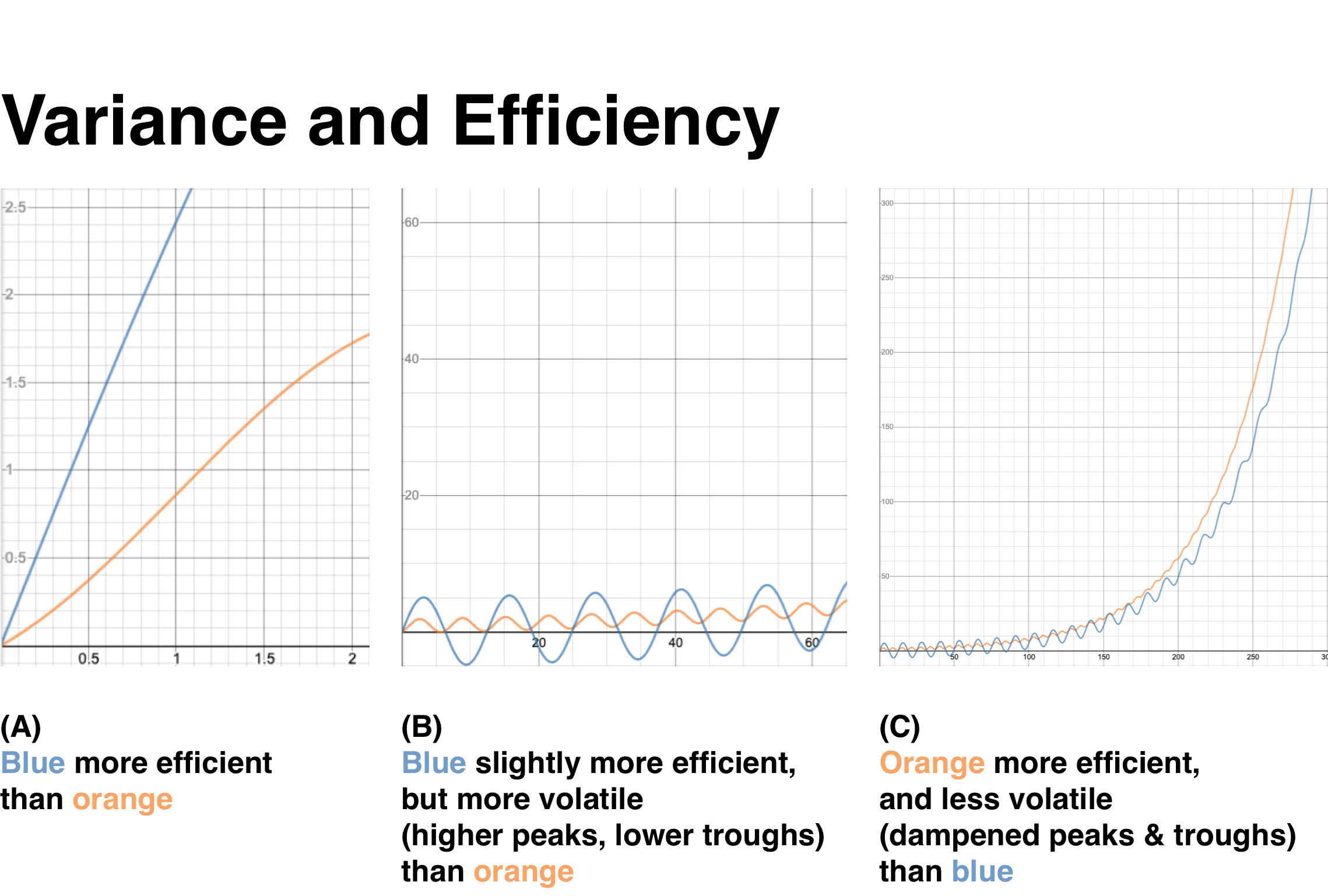
If we are to make any progress towards addressing the root causes of the deepest social and economic problems that lie ahead of us, I firmly believe we need to stop talking in terms of absolutes and start talking in terms of trade offs.
This will be more intellectually demanding on policy makers and citizens alike.
As an example, let’s talk about government efficiency.
I have increasingly heard business operators speak with a bit of envy about the efficiency of China’s centralized economy and government when compared with the bureaucratic morass of American politics.
While it’s true that China has been on a bit of an economic tear for some years, it is important to remember that the US government was designed for more than short term economic growth and rapid policy change.
Let’s imagine that China’s economic growth over the past decade looks something like the blue curve (with the steeper slope) and growth in the United States might look more like the orange curve in figure (A).
The same efficiency of leadership and execution that result in figure (A) in the short term under a relatively benevolent dictator or centralized authority, might over iterated runs suffer from nepotism and begin looking more like (B) or (C), where sharp slopes of improvement under good leaders might be followed by sharp declines under bad ones.
Even if the long term picture looks like (B) with centralized authority yielding a higher global maximum at the end of a long term, the volatility of that pace of progress might not be worth it.
And the jury is still out on whether democracy will produce better results and more efficient progress in the long term, as depicted in (C).
TINSTAAFL
- Volatility vs Efficiency (Growth)
- Consensus (Noble Lie) vs Accuracy (Science)
- Private Plunder vs Public Graft
- Explore (Discovery) vs Exploit (Execution)
- Higher Risk vs Lower Return
- Bird in Bush vs Bird in Hand
- Gameover Failure vs Take Damage Failure
- Freedom vs Equality
- Rights vs Responsibilities
- Open Borders vs Welfare State
- Having Cake vs Eating it Too
- Promising Everything vs Admitting Tradeoffs
- Fault Tolerance vs Low Cost / High Efficiency
- Availability vs Reliability
Volatility vs Efficiency is just one tradeoff we might address in a sober policy discussion. There are many others (some of which are listed here), and perhaps more importantly than any of these specific tradeoffs is the idea that each tradeoff implies a metric (or metrics) that you are trading between.
A huge number of systems problems boil down, I think, to measurement problems. We see really strange behavior when we measure the wrong thing – either because we thought it was the right thing itself at one time, or because we thought it was a good proxy correlated to the actual thing we wanted to change.
Successful institutional reform will require us to measure the right things, which will create the right incentives for those working on change.
We have built incredibly efficient systems optimized for the metrics we track today: GDP, attention, votes.
If we had metrics that tracked more closely to the outcomes we cared about, I’m sure we’d build systems that just as efficiently achieved those ends.
This is no easy task, however.
First, we need to figure out how to choose the objective function we want to aim for, and catalog the acceptable tradeoffs. In a pluralistic culture, even deciding upon this will be a challenge.
Second, once we decide the common goals, we will need to develop the best metrics for tracking towards those goals. This too is quite difficult when dealing with complex systems.
Third, in order to decide upon common goals and the metrics we’ll use to track progress towards them, we’ll need cooperation from institutions whose current incentives may not be aligned with those that we decide are optimal going forward.
Double Bind
This recommendation presents a sort of double bind.
Our aim is to escape the runaway feedback loops of a consumer capitalist “AI” system which has become incredibly efficient at commanding our time, our wants, and our attention.
Yet in order to perform a “software update” to the basic rules of this system that is leading us toward a dystopian future, we need to distribute ideas about the root causes of institutional problems and their potential solutions. But, distributing ideas for change and reaching consensus on a plan requires the attention of a population that we have just stated is trapped in feedback loops optimized for producing and consuming entertainment and polemical rhetoric.
My current thought on how we escape this double bind feels so illusory, so much like changing the engine of a plane while flying it, that I am still trying to work out if it is actually viable, or whether I have just tricked myself into thinking it is… but here it is…
Since our systemic failures boil down to incentives problems, perhaps we can introduce a set of delicate changes that we can come to consensus upon because (i) we have a clear understanding of how they might produce better results for everyone in the long term and (ii) in the short term, they post a minimal disruption to each actor’s pursuit of their own incentives (or, at the very least, the changes are equally disruptive opponents with conflicting incentives).
Practical Recommendations
Now, lest this be one of those critiques where I only point at problems or provide abstract principles but no concrete recommendations, here are a few examples of the types of delicate changes might be useful:
(1) Strict rules for public political discourse, moderated by bipartisan arbiters. Because politicians compete for attention with other forms of media, there’s a sort of arms race where they employ whatever rhetoric garners the most attention when talking to the public media. The result is polarizing and emotional rhetoric that does little to inform and instead just confirms existing biases. One arena where you see heated debate moderated in pursuit of the truth is in a court of law, where certain types of remarks and rhetoric which are deemed inadmissible are nullified by judges. We are starting to see similar trends towards use of rubrics of objective evidence by corporations in their interview processes. We could define a similar set of rules for political discourse (ban ad hominem attacks, encourage the principle of charity and acknowledgement of tradeoffs, etc) and appoint bipartisan judging panels to moderate).
(2) Peg salaries of institutional leaders to the median income. One of the most inflammatory metrics cited in conversations about economic disparity is the stagnation of median income. Pegging the salaries of Senators, Congressman, Supreme Court Judges, etc, to the median income might provide a nice alignment of incentives, if this is a metric we care to have our policies optimized for.
(3) Adopt OKRs in public institutions. Today, politicians are measured strictly by votes. In business, sports–even in some non-profits–where there is a desire to measure leaders on their efficacy in executing towards real goals, we have more rigorous frameworks. One that might be worth trying for elected officials is called Objectives and Key Results. An elected official using OKRs would define what they want to accomplish during their term, define the metrics that would measure success, and at the end of the term, publish a retro discussion and score for each of these metrics, explaining progress (or failure). These scorecards might feed into the next election as hard data on the leader’s ability to achieve their goals.
(4) Take party polarization as a given, and design for cooperation around it. Our two parties are so polarized right now that we end up in one of two failure modes depending on how the various branches of government are controlled. When a single party occupies several branches of government that are intended to check one another at the federal level, it makes sense for that party to go on a spree, enacting as much partisan policy as they can. When different parties occupy different branches, they deadlock one another, and try to stymie as much progress as possible, and hope for more complete control in the next cycle. [] At other levels of government, you might see inaction, because any action taken is something you might be criticized about in the next election cycle, whereas inaction leads you less vulnerable to attack future debates.* We might mitigate both of these by conceding the ideological gap between the two parties, and design a system where parties flip-flop control of various branches of government–for example, whenever we have a Republican President, we ensure Democratic control of the Congress, and vice-versa. If everyone understood that all future iterations of control would be balanced in this way, there might be more incentive to cooperate, coordinate, and negotiate to get things done in the current cycle (vs waiting for the next imbalance).
(5) Set boundary parameters around economic growth and disparity. Instead of incessantly bickering about the dystopias that result from either raw economic growth without redistribution (which inevitably leads to extreme disparity) or the state enforcement of absolute equality (which leads to either stagnation or totalitarianism), we should define policies that moderate between these extremes and land us in explicit, acceptable ranges. We could, for example, set parameters such that whenever the economy is growing as a whole, we have a redistribution slider which ensures inequality decreases at the same time (see the 𝜏 parameter in this post).
(6) Surgeon General’s Warning for Media. One policy aimed at reducing consumption of an addictive substance that has show to have long term negative effects on consumers is the requirement for warning labels on tobacco products. Another effort to improve consumer awareness of health impacts on consumption is FDA labeling of food products. Information and media are produced much more rapidly and in a more bespoke manner than industrialized food and drugs, but might benefit from similar warning labels about the likely usefulness of particular media towards certain ends. While much more difficult to quantify as precisely as nutritional information, we might be able to broadly label pure entertainment (photos of cats or beautiful people) vs content with a specific political bias vs information with a potentially practical application. A less dramatic version of this idea would be an opt-in browsing extension that allows media consumers to access this information or limit their information diet in other ways (eg, hours spent per day) – the problem with the weaker implementation, however, is that the people that might benefit the most might not opt in.
“Hope is not a strategy.” – Site Reliability Engineering, Beyer et al.
“The structures of a pattern are not themselves solutions, but they generate solutions. Patterns that work this way are called generative patterns.” – A Pattern Language, Christopher Alexander
It is easy to feel we are heading towards dystopian future–or even that we are already, in many ways, living in a dystopian present–when you are constantly subject to feedback loops optimized for the satisfaction of short term desires but clearly not aligned with your longer term interests.
It is natural to revolt against these complex and inscrutable social and economic systems, and think the answer lies in a return to something simpler.
But rather than giving up all of the benefits of “AI” systems like capitalism and attention democracy as soon as we begin to see suboptimal outcomes, instead we should remember the advantages of these systems. They have eliminated a huge amount of exposure to the uncertainty of nature–things like disease, famine, natural disaster, etc. They also reduce our exposure to the mistakes or ill will of individual human actors.
Hoping for good people–and only good people, who never make mistakes–to come into power, is not a strategy.
If handing over the reigns of control to “AI” systems reduces our exposure to single points of human failure, I for one will welcome the reign of the robots. We just need to ensure the parameters of these systems are well understood and well tuned, which clearly still needs work given the current state of consumer capitalism and the attention economy.
References
- The Crack Up, Fitzgerald.
- There is something wrong on the internet, Bridle.
- Universal Paperclips, notes, Lantz.
- Ethical Issues in Advanced Artificial Intelligence, Bostrom.
- Economic and Philosophic Manuscripts of 1844, Marx.
- E Unibus Pluram: Television and U.S. Fiction, Wallace.
- The short history of global living conditions, Our World in Data.
- Vintage Soviet Propaganda Posters From The Era Of Stalin And World War II, Paoletti.
- The Revolt of The Public and the Crisis of Authority in the New Millennium, Gurri.
- The Road to Serfdom, Hayek.
- Leviathan, Hobbes.
- Thinking in Systems, Meadows.
- The Evolution of Trust, Case.
- iterated prisoner’s dilemma, Wikipedia.
- The Strategy of Conflict, Arms and Influence, Micromotives and Macrobehavior, Schelling.
- Fault Tolerance in a High Volume, Distributed System, Netflix.
- fault tolerance, Wikipedia.
- durability, Wikipedia.
- redundancy, Wikipedia.
- consistency, Wikipedia.
- availability, Wikipedia.
- my variance vs efficiency graph, Kortina.
- Lessons from History, Durant.
- Multi-armed bandit, Wikipedia.
- Failure Margins and Feedback Loops, Kremins.
- Engineering Interviews Grading Rubric, Medium.
- principle of charity, Wikipedia.
- Measure What Matters, Doerr.
- Take Control, Center for Humane Technology.
- Wealth Redistribution and Interest Rates, Peters.
- Site Reliability Engineering, Beyer et al.
- A Pattern Language, Alexander.